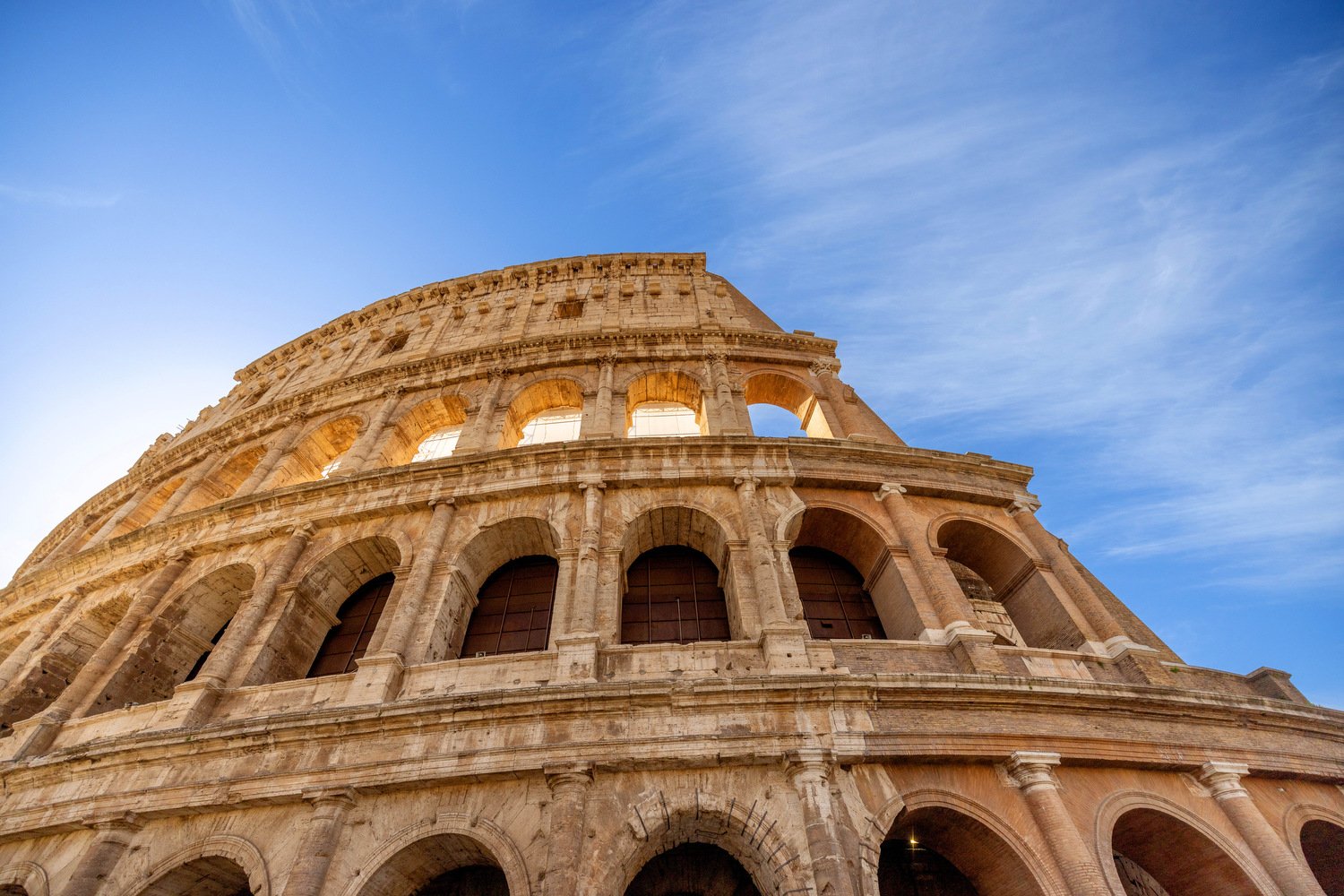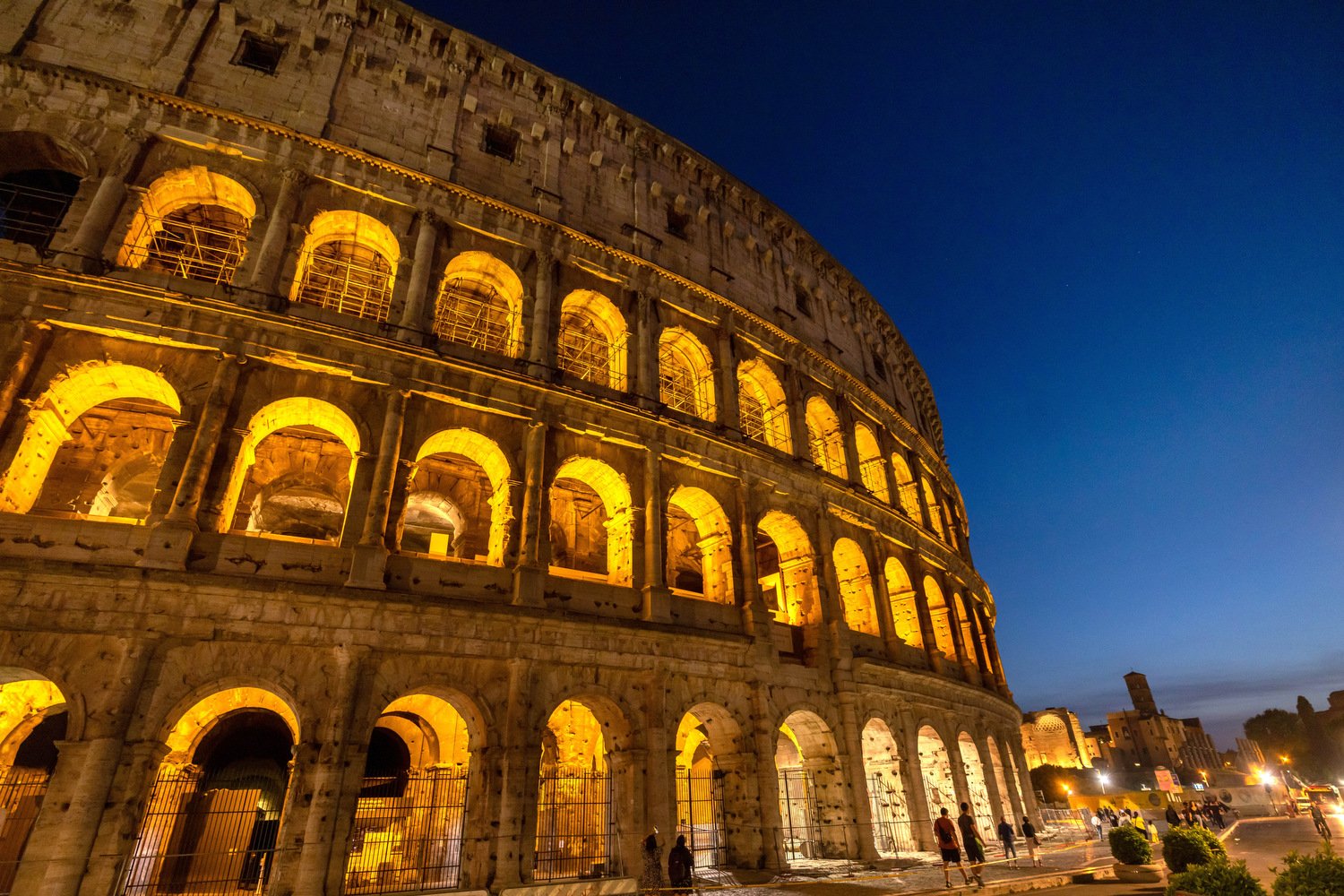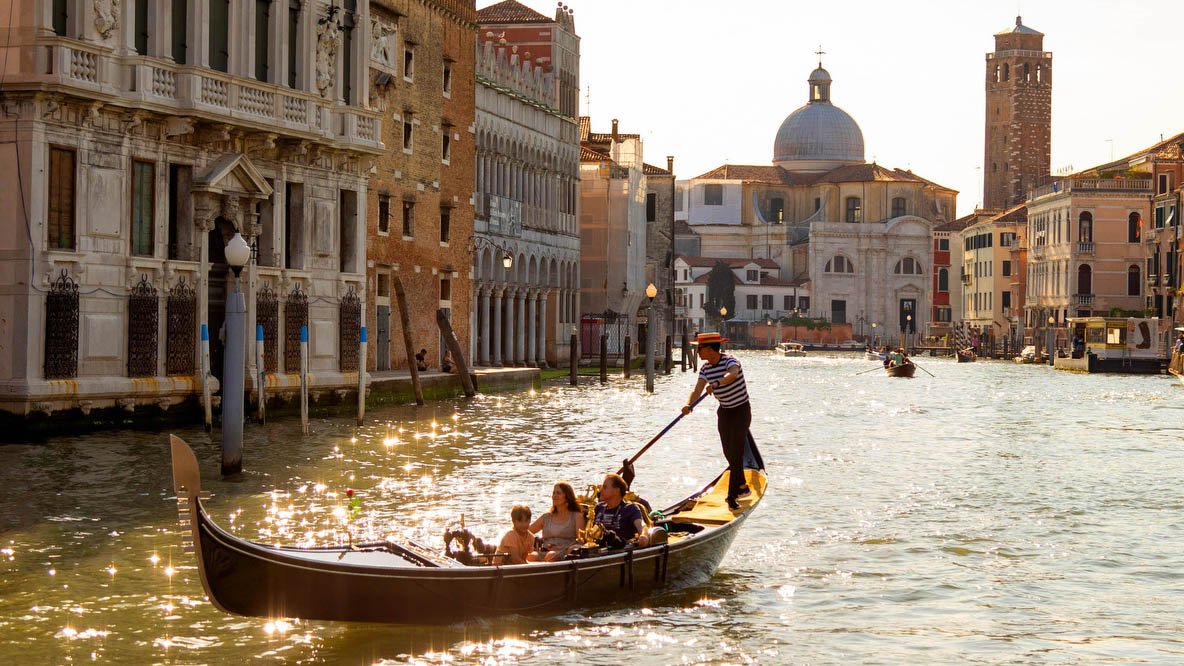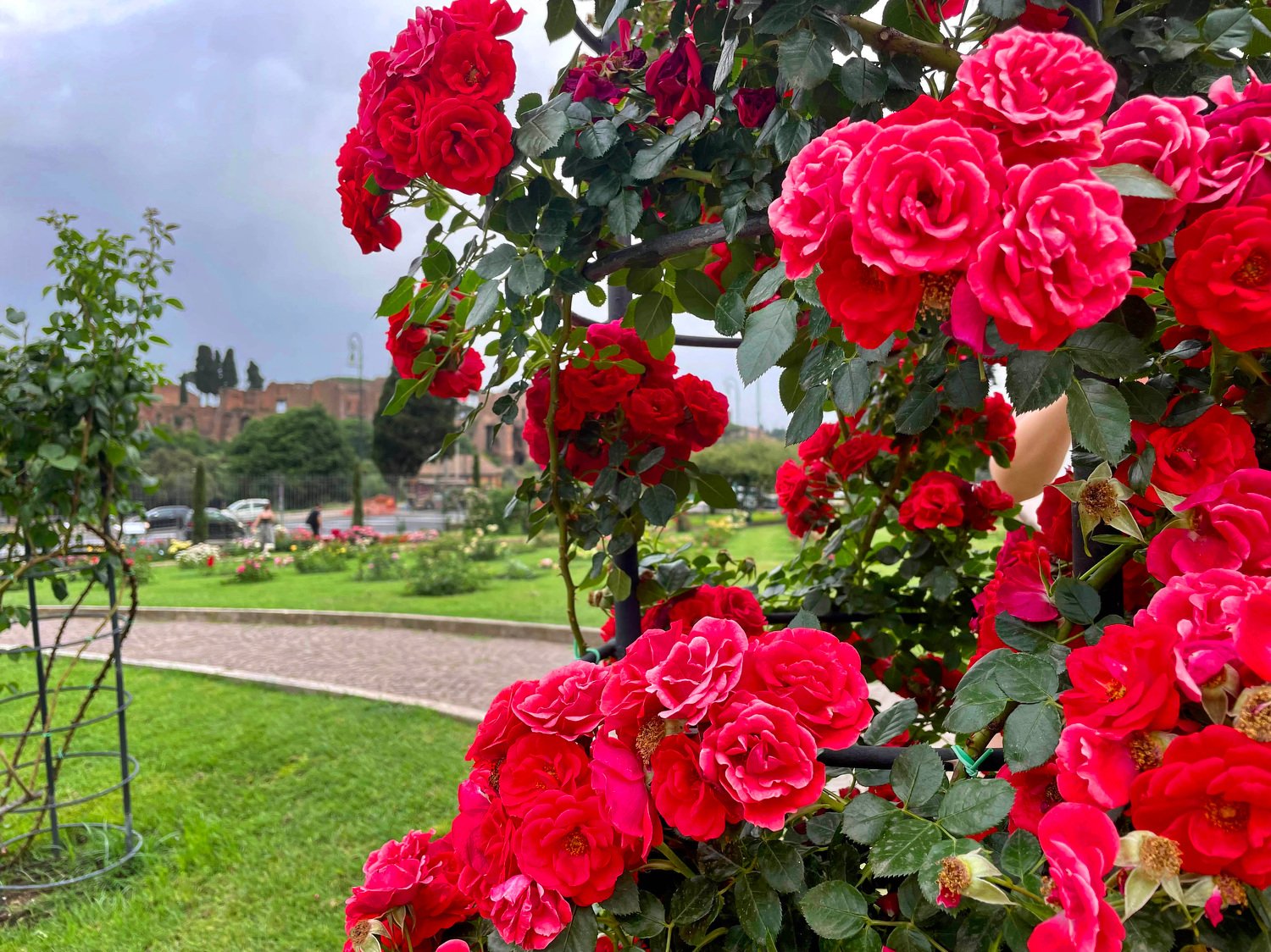Visiting the Roman Colosseum: advice and tips for 2025
Dusk is a wonderful time to visit the outside of the Colosseum. As you can see above the lighting is spectacular and it’s a cooler time of day.
This post contains the latest information for purchasing tickets for the Colosseum in Rome for 2025..The good news is that purchasing tickets has gotten easier!
In May of 2024, the Parco Colosseo launched a NEW website for purchasing tickets directly from the Parco Colosseo. This was GREAT news, because the website is very clear and easy to use.
How to purchase tickets is detailed below in the Getting Tickets to the Colosseum in Rome section of this post.
We recommend taking a guided tour for best experience, and now you have several options for booking a guided tour as well as a self-guided ticket through Parco Colosseo. Certain types of tours, however, such as a guided tour through the Roman Forum and Palatine Hill, would still have to be booked through an outside private tour company.
Remember that not all “secondary ticketing” websites are reputable.
That’s why we still recommend Viator or GetYourGuide, as reputable independent tour companies that aren’t going to scam you. (We are affiliates of both these companies and recommend them often: but that is because we have used them and they have good reputations.)
The Colosseum is definitely worth visiting, but you just need a plan. Unfortunately, it’s not a site where you can just “wing it “ easily these days, and with 2025 being a Jubilee Year for the Vatican, even more visitors to Rome than usual are expected.
To make your planning easier, we’ve put together some tips to help you plan an enjoyable visit to the Roman Colosseum.
Why should I visit the Colosseum in Rome?
It’s one of the Seven Wonders of the World. That puts it in pretty good company with the likes of The Great Wall of China and the Christ the Redeemer statue in Brazil. C’mon, this is why we travel, right? Seeing something for yourself opens up a different kind of understanding. As my dear sister Celeste would say - “Go! Travel! See Europe!” I think everyone needs a Celeste in their life encouraging them to see things.
As “big tourist sites” go, the Colosseum in Rome just might outdo them all. Built nearly 2000 years ago, it is still the biggest amphitheater in the world. Despite its age, no modern structure has yet to surpass it. Although missing a few pieces, it has survived fires, earthquakes, war, and neglect throughout its long history. Its solidly imposing presence certainly gives the impression that it will be standing for another 2000 years! Nothing you can see in the US is this old.
The ticket to the Colosseum also includes admittance to The Roman Forum and The Palatine Hill. These are significant ruins to explore in their own right, so that makes a pretty good bang for your buck! You can wander around these sites and really get the feel of early Roman life. The Roman Forum was an important location for daily activities like hearing public speeches, discussing politics or just visiting shops and taverns.
The Colosseum has a very interesting story to tell stretching from the once vast Roman Empire into more “modern” times. You might be surprised to learn that gladiator fights were not exactly as they are depicted in movies. Or that the Colosseum became a symbol of the international campaign against capital punishment, which was abolished in Italy in 1948, and became the site of anti-death penalty demonstrations in 2000. In fact, there are many chapters in the building’s life that may surprise you!
A classic view inside the Roman Colosseum.
Getting tickets to the Colosseum in Rome
The website for purchasing tickets to the Colosseum in Rome as of May 2024 is Parco Archeologico de Colosseo.
It is best to purchase a timed ticket ahead of time online, since lines can be very long to purchase a ticket in person, and you may have to wait to enter even after you buy the ticket. Also, tickets may run out before you get to the front of the queue!
You can choose between several language translations, and the very first thing you see at the top of the page is the different categories of ticket offerings.
I think the best general guided tour offering for most people would be the standard €26.00 “Colosseum guided tour”, which takes you through the main floor of the Colosseum with lots of information and includes entry into the Roman Forum and Palatine Hill, but for that part, it would not include a guide.
There are several variations of “Full Experience” guided tours, for full descriptions, check out this page. For the most part, these are more expensive and more restricted.
Touring the Underground of the Colosseum is a very high demand ticket, and very restricted in numbers because it is an archeologically sensitive area. Unfortunately, these sort of things sometimes become “trendy” as the coolest way to see a place. Honestly, you can see most of the Underground from above - since the “roof” of the Underground is missing. There’s only a very small section of it that is still enclosed. So no need to overpay for the experience!
The most available ticket, and therefore easiest to book, is the Individual ticket, which is self-guided and gives you access to the main level of the arena and the Roman Forum and Palatine Hill. Most visitors would be satisfied with this level of ticket, unless you have a very keen interest. You can also use the handy free app for an audio tour as you go at your own pace. The Parco Archeologico de Colosseo MyColosseum app can be dowloaded from the Apple App Store or Google Play Store.
An interesting new Individual ticket offering is the new 24-Hour Arena Only ticket. This includes one admission to the Arena floor only at a booked time, through a designated entrance. You enter the floor, spend 20 minutes or so, then exit the Arena. It also includes one admission to the Roman Forum-Palatine archaeological area and Imperial Fora, entry to SUPER sites, and any exhibitions that may be in progress in the Roman Forum-Palatine archaeological area. This ticket might be a good choice for anyone who wants to see the Arena but doesn’t want to spend a lot of time there. It may be a good option with children.
Another new offering are selected Night Tours during the summer season.
Though the Colosseum is open year round, last admission in winter may be as early as 3:30pm, so always check the website before you go. The Colosseum is closed on January 1st and December 25th.
If booking your tour through a third party affiliate, use a reputable tour operator, such as Viator or GetYourGuide,.
Note - This blog post contains affiliate links. This means that if we are recommending a product, activity, or hotel, we might be receiving a small commission if you buy or book from these links. This is done at no additional cost to you. We only recommend products we have personally used or have thoroughly researched.
Italy's culture ministry announced earlier this year that it plans to introduce Colosseum tickets with the names of visitors printed on them. Ticket-holders may now be required to present "a valid identification document, as happens for football matches". So remember to bring your ID to the Colosseum.
An archway leading to the interior of the Roman Colosseum.
Why take a guided tour of the Colosseum?
Firstly, tours can get you in early with “skip the line” convenience. We went early in the morning and had a great experience as there were much fewer people milling around. Even though tickets must be purchased ahead and you can’t get a ticket by just showing up and waiting in line anymore, it can still be a confusing scene around the Colosseum. And even with your timed ticket, you still have to get in the queue. Tour operators generally take care of all that “hard stuff” for you.
It can be a little dry to visit the Colosseum site on your own. It’s not well marked, so it’s hard to appreciate what you are looking at or learn anything. But if you have your heart set on going it alone, we would recommend at least using an audio tour - use the free official app MyColosseum from Parco Colosseo or use one that Rick Steves offers through his Audio Europe App.
Tour guides know things! We had a delightful Viator guide who was also an archeological master’s degree student who had lots of insight into the different time periods and up-to-date information on new discoveries and ideas. She was happy to answer our questions as well. Tour guides have a lot of experience with the site and know what is going on. Even by sharing something silly like the story of the cat who lives in the Colosseum and is somewhat of an unofficial mascot, they can make it all easier to connect to in modern life.
Note - The most well-known cat of the Colosseum, called Nerina, died in 2021 after ten years of popularity, but an orange tabby seems to have taken her place.
Entrance to the Roman Forum is included with the Colosseum admission ticket.
How to get to the Colosseum in Rome
The Colosseum is located about 1 km southeast of the historic center of Rome.
By train -The metro is the easiest and fastest way to reach the Colosseum. Take line B towards the Colosseo station. This puts you right in front of the amphitheater. Can’t miss it!
From Roma Termini, it takes only about 2 to 4 minutes by metro to reach the Colosseum.
By bus - Bus is another option, but it takes longer, about 12 minutes from Roma Termini.
To reach the Colosseum by bus, lines 38 and 75 depart from the northern regions of Rome. From the south, use buses 175 and 271.
The Colosseum has its own bus stop at Piazza del Colosseo, right in front of the entrance.
By tram - Tram is another option to get to the Colosseum. Board Tram line 3 or 8 to The Piazza del Colosseo tram stop.
All of Rome’s public transportation is run by one company called ATAC. You can use the same ticket for metro trains, trams, buses, and light rail. We got a multi-day pass that was most convenient for our stay in Rome.
We purchased our passes at the metro station and they are also available at most “tabacchi” – tobacco stores, distinguished by the “T” sign outside.
As of January of 2023, a Tap-&-Go system was being rolled out by the ATAC; metro stations fitted out with turnstiles accepting contactless credit and debit card payments, as well phone payment systems like Apple Pay and G-Pay.
Busses and Trams are now being added to the Tap&Go system.
Some practical tips for your visit to the Roman Colosseum
- Book early - Although the new Parco Colosseo website has made buying tickets much, much easier than it was in the past, it’s still a very popular attraction, so demand for tickets is hight. As soon as you know when you are going to be in Rome, book your tour or buy your tickets.
- Visit at off times - The Colosseum is obviously a very popular tourist destination and it’s guaranteed to be crowded inside. Book the earliest tour that you can for the best experience. Opening times are seasonal, but generally, it’s either 8 or 9am.
- Visit off-season - Summer is a busy tourist season and it’s also incredibly hot in Rome at that time. So if it is possible to be flexible with your travel dates, try visiting Rome off-season. The Colosseum is open year-round except for January 1 and December 25. Take note, however, that last admission in winter may be as early as 3:30pm, so always check the website before you go.
Winters are mild in the Mediterranean climate, but if you still like it a little warmer, consider visiting between April and early May or between late September and October. We went in May and the mornings were beautiful though afternoons got hot.
John photographing the Roman Colosseum at dusk. Dusk is an amazing time to walk around the exterior.
- Restroom facilities - There’s only one bathroom at the Colosseum. As you enter the arena, to the left of the ticket booths, you will see the toilets. Use it when you get there because a guided tour generally takes about 2 hours.
- Bags - Backpacks and rolling bags are not allowed; if you show up with one, you will be denied entry. I had a small purse and that was no issue.
- What to wear - Dress comfortably - more for a hike in summer than for a breezy photo op. Sorry Instagrammers! Wear comfortable shoes - there are very old, surprisingly steep steps everywhere, at the Roman Forum as well. Also, wear sunscreen and you may also want a hat, even in winter. The Roman sun is hot! There is a lot of walking involved in visiting both the Colosseum and the other ruins around it and not too many places to hide or rest, but we did manage to find some rocks under the trees at the Forum to take a short break.
- No re-entry! - You can go straight from the Colosseum to the Roman Forum, but you cannot re-enter once you leave.
- Water - You definitely need to hydrate while visiting the Colosseum - remember there’s no roof so you will be in the sun! However, glass bottles or full plastic ones are not allowed. But you can bring in an empty bottle and fill it inside the Colosseum or the Roman Forum at one of the many “nasoni” - water fountains.
- Food - As a World Heritage site, the Colosseum does not have dining options within its walls. You can bring a few snacks to munch on while you walk, but there is nowhere to sit and dine.
If you would like to have lunch or dinner after you exit, there are lots of places just outside, but we STRONGLY recommend you try to get out of the immediate area. These are generally tourist traps; expensive, food not so great, and you might get scammed or intimidated into leaving unnecessary gratuities, making for a disappointing experience. We talk more about this and other tips in our blog post 11 Tips for Traveling in Italy.
Dusk is a wonderful time to photograph the Roman Colosseum. For more photo advice you can read our blog post: 6 photo tips for traveling in Italy.
The Colosseum at Night
For beautiful photos, don’t forget to come back and experience the Colosseum at night! It is dramatically lit and against an azure evening sky, with perhaps a few stars twinkling - or even Jupiter as we were lucky to see - it is really so romantic and lovely. Go ahead - take some pictures!
We also enjoyed watching preparations for the Republic Day parade (June 2) - always something going on in Rome!
What else can I see in the area around the Roman Colosseum?
Rome is a great walking city, with things to see everywhere you look! While visiting the Colosseum, the Rome Forum, and Palatine Hill, here are some other points of interest not too far away!
The Great War Memorial - Not far from the Colosseum, on the Capitoline Hill, in the symbolic center of ancient Rome, stands the Vittoriano, a large national monument built between 1885 and 1935 to honor Victor Emmanuel II, the first king of a unified Italy. You really can’t miss it, as it’s enormous, and it is topped with imposing statues of chariots that rise high into the sky, not to mention the GIANT statue of Emmanuel himself on horseback in front.
The marble structure itself is meant to represent a sort of modern forum, though it is sometimes uncharitably called a “wedding cake” or “typewriter” by those who find it to be rather a miss architecturally. As with a lot of historical features of Rome, this monument has a bit of a complicated history, but after World War I, the Tomb of the Unknown Soldier was placed here, and thus it became somewhat regarded as a War Memorial, though that wasn’t the original theme.
Its pure size is what makes it impressive, and also what makes it controversial in many ways. From the onset of it being built, the ostentatious use of marble and just the excessiveness of it all ran counter to the image of Rome as the capital of classicism. It still triggers mixed emotions today.
For 12 Euros, you can go inside. There is a museum, but most interesting to me is the roof! You can take a lift up to the Panoramic Terrace and experience stunning views of the city, including the Colosseum and the Roman Forum. It’s a little expensive just for a view, but I do enjoy a good vista!
The Great War Memorial in Rome.
Rome Rose Garden - As this area of Rome can be pretty exhausting with the hustle-bustle of the busy city plus all the tourist activity, the Rome Rose Garden (The Roseto Comunale) is a nice relief from the sensory overload. Italy has long adored the rose, in fact, there originally were public rose gardens located at the Colosseum! But those were destroyed during WWII. Eventually, in 1950, the tradition of the Roman public rose garden was re-established at the site we see here today, about a 15-minute walk from the Colosseum. Entry is free but it’s only open to the public for a short period of time, from late April through the middle of June.
The Rome Rose Garden boasts over 1,100 varieties of roses, and we loved it so much, we wrote a whole post about it - The Rose Garden of Rome. Take a look for lots of information.
Circus Maximus - If you haven’t had your fill of ruins yet, Circus Maximus is not far away! It’s quite close to the Rose Garden, and has its own metro stop. Circus Maximus was the largest stadium in ancient Rome and built for chariot races.
It’s pretty low key to visit; you can just walk around at your own pace. You can also see great views of the ancient structures of the Park of the Aqueducts from there.
View of Circus Maximus
Trastevere - For a calm ending to a busy day, we highly recommend dinner in Trastevere, Rome’s charming, quiet neigborhood that features some great restaurants. It’s about a 15-minute walk from the Rose Garden, or 30 minutes if you are coming straight from the Colosseum. Crossing over the Tiber River, you will feel the vibe change and slow down, and you’ll be in for a lovely evening.
Pedestrians walk past outdoor restaurants in Trastevere.
Lastly, let’s show the Colosseum some love
Did you know - the Colosseum wasn’t always truly appreciated for the historical treasure it is?
In fact, it went through various periods of neglect.
With the fall of the Roman Empire, the Colosseum fell into a state of abandonment. Powerful Romans would often use ruins as a quarry, carting away stones and precious metals.
The travertine stone of the Colosseum was used in the building of Palazzo Barberini, the Basilica of Sant’Agostino, Palazzo Venezia, Palazzo della Cancelleria, and even for some parts of St. Peter’s Basilica! It also was used to build the containing walls of the Tiber River. It’s everywhere! No wonder so much of it is missing!
Also, in the years after World War II, the Colosseum became a location for black market activity, as many items had become scarce after the war. It was considered a seedy neighborhood at that time, and a good spot to carry out illegal transactions. You can still see markings on the walls (pointed out by our tour guide) where sellers advertised their goods and prices.
It only became a World Heritage Site in 1980! And it wasn’t even elected as one of the New Seven Wonders of the World until 2007. I find that pretty astonishing.
With recent stories in the news about errant tourists carving their initials in the wall of the Colosseum, I just thought maybe we should all stop and take a moment to give this magnificent artifact a little love and consideration. After all, it has seen a hell of a lot and has much to tell us.
Now “Go! Travel! See Europe!” - you said it, sister!
This post was researched and written by Debbie of the Empty Nest Explorers. You can learn more about the Empty Nest Explorers here.





















